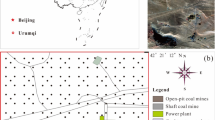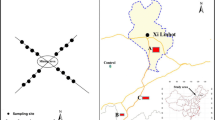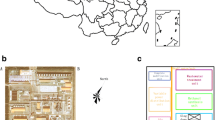Abstract
Coal mining area is highly subject to lead (Pb) pollution from coal mining activities. Several decades of coal mining and processing practices in dozens of coal mines in the Huainan Coal Mining Area (HCMA) have led to the accumulation of massive amounts of coal gangue, which piled in dumps. In order to investigate the impacts of coal gangue dumps on Pb level in the supergene media of the HCMA, a systematic sampling campaign comprising coal gangue, soil, wheat, and earthworm samples was conducted. The average Pb content in the coal mining area soil is 24 mg/kg, which is slightly higher than the associated coal gangues (23 mg/kg) and markedly higher than reference region soil (12.6 mg/kg). Soil in the HCMA present a slight to moderate Pb contamination, which might be related to the weathering and leaching of coal gangue dumps. Lateral distribution of Pb in HCMA soil differed among individual coal mines. The soil profile distribution of Pb depends on both natural and anthropogenic contributions. Average Pb content is higher in roots than in stems, leaves, and wheat husks, while the Pb level in seeds exceeded the maximum Pb allowance for foods (Maximum Levels of Contaminants in Foods of China, GB 2762–2012). Earthworms in the selected area are significantly enriched in Pb, suggesting higher bio-available Pb level in soil in the HCMA.








Similar content being viewed by others
References
Alloway, B. J., & Jackson, A. P. (1991). The behavior of heavy metals in sewage sludge-amended soils. Science of the Total Environment, 100, 151–176.
Boussen, S., Soubrand, M., Bril, H., Ouerfelli, K., & Abdeljaouad, S. (2013). Transfer of lead, zinc and cadmium from mine tailings to wheat (Triticum aestivum) in carbonated Mediterranean (Northern Tunisia) soils. Geoderma, 192, 227–236.
Canfield, R. L., Henderson, C. R., Cory-Slechta, D. A., Cox, C., Jusko, T. A., & Lanphear, B. P. (2003). Intellectual impairment in children with blood lead concentrations below 10 μg per deciliter. The New England Journal of Medicine, 348, 1517–1521.
Carrillo-Gonzalez, R., Šimůnek, J., Sauve, S., & Adriano, D. (2006). Mechanisms and pathways of trace element mobility in soils. Advances in Agronomy, 91, 111–178.
Chen, X. Y., Huang, H., & Sang, H. Q. (2006). The application of the index of geoaccumulation to evaluate heavy metal pollution in sediments in the Huainan section of the Huaihe River. Journal of Anhui University of Science and Technology (Natural Science), 20(2), 35–38 (in Chinese with English abstract).
Chen, J., Liu, G. J., Jiang, M. M., Chou, C.-L., Li, H., Wu, B., et al. (2011). Geochemistry of environmentally sensitive trace elements in Permian coals from the Huainan coalfield, Anhui, China. International Journal of Coal Geology, 88(1), 41–54.
China National Environmental Monitoring Centre (1990). China soil background values. China Environmental Science Press, Beijing.
Dang, Z., Liu, C. Q., & Haigh, M. J. (2002). Mobility of heavy metals associated with the natural weathering of coal mine spoils. Environmental Pollution, 118, 419–426.
Das, S. K., & Chakrapani, G. J. (2011). Assessment of trace metal toxicity in soils of Raniganj Coalfield, India. Environmental Monitoring and Assessment, 177(1–4), 63–71.
Diego, A. D. L., & Paloma, R. A. (2012). Trace elements: environmental sources, geochemistry, and human health. Hauppauge, New York: Nova Science Publishers.
Edwards, C.A. (2004). The importance of earthworms as key representatives of the soil fauna. Earthworm Ecology, Boca Raton, Florida, CRC, 3–11.
Fang, T., Liu, G. J., Zhou, C. C., Sun, R. Y., Chen, J., & Wu, D. (2013). Lead in Chinese coals: distribution, modes of occurrence, and environmental effects. Environmental Geochemistry and Health. doi:10.1007/s10653-013-9581-4.
Hakanson, L. (1980). An ecological risk index for aquatic pollution control: a sedimentological approach. Water Research, 14(8), 975–1001.
Ji, K., Kim, J., Lee, M. J., Park, S., Kwon, H.-J., Cheong, H.-K., et al. (2013). Assessment of exposure to heavy metals and health risks among residents near abandoned metal mines in Goseong, Korea. Environmental Pollution, 178, 322–328.
Kahapanagiotisa, N. K., Steheittb, R. M., & Lester, J. N. (1991). Heavy metal complexation in sludge-amended soil. The role of organic matter in metal retention. Environmental Technology, 12(12), 1107–1116.
Ketris, M. P., & Yudovich, Y. E. (2009). Estimations of Clarkes for carbonaceous biolithes: world averages for trace element contents in black shales and coals. International Journal of Coal Geology, 78(2), 135–148.
Lăcătuşu, R. C., Răuţă, C., Cârstea, S., & Ghelase, I. (1996). Soil-plant-man relationships in heavy metal polluted areas in Romania. Applied Geochemistry, 11, 105–107.
Lang, F., & Kaupenjohann, M. (2003). Effect of dissolved organic matter on the precipitation and mobility of the lead compound chloropyromorphite in solution. European Journal of Soil Science, 54, 139–147.
Lanphear, B. P., Hornung, R., Khoury, J., Yolton, K., Baghurst, P., Bellinger, D. C., et al. (2005). Low-level environmental lead exposure and children’s intellectual function: an international pooled analysis. Environmental Health Perspectives, 113, 894–899.
Li, Q., Cheng, H. G., Zhou, T., Lin, C. Y., & Guo, S. (2012). The estimated atmospheric lead emissions in China, 1990–2009. Atmospheric Environment, 60, 1–8.
Liu, H. Y., Probst, A., & Liao, B. H. (2005). Metal contamination of soils and crops affected by the Chenzhou lead/zinc mine spill (Hunan, China). Science of the Total Environment, 339, 153–166.
Mapanda, F., Mangwayana, E. N., Nyamangara, J., & Giller, K. E. (2007). Uptake of heavy metals by vegetables irrigated using wastewater and the subsequent risks in Harare, Zibabwe. Physics and Chemistry of the Earth, 32, 1399–1405.
Monna, F., Hamer, K., Leveque, J., & Sauer, M. (2000). Pb isotopes as a reliable marker of early mining and smelting in the Northern Harz province (Lower Saxony, Germany). Journal of Geochemical Exploration, 68(3), 201–210.
Müller, G. (1969). Index of geo-accumulation in sediments of the Rhine River. Geojournal, 2, 108–118.
Needleman, H. L., Riess, J. A., Tobin, M. J., Biesecker, G. E., & Greenhouse, J. B. (1996). Bone lead levels and delinquent behavior. Journal of the American Medical Association, 275, 363–369.
Qi, C. C., Liu, G. J., Kang, Y., Lam, P. K. S., & Chou, C. L. (2011). Assessment and distribution of antimony in soils around three coal mine, Anhui, China. Journal of the Air & Waste Manage, 61, 850–857.
Shah, F., Kazi, T. G., Afridi, H. I., Baig, J. A., Khan, S., Kolachi, N. F., et al. (2010). Environmental exposure of lead and iron deficit anemia in children age ranged 1–5 years: a cross sectional study. Science of the Total Environment, 408(22), 5325–5330.
Shi, Y. H. (2006). The Pb of coal-mining wastes in Huainan and its environmental effect. Journal of Hubei Institute for Nationalities (Natural Science Edition), 24(3), 270–274 (in Chinese with English abstract).
Sizmur, T., & Hodson, M. E. (2009). Do earthworms impact metal mobility and availability in soil?—a review. Environmental Pollution, 157(7), 1981–1989.
Surkan, P. J., Zhang, A., Trachtenberg, F., Daniel, D. B., McKinlay, S., & Bellinger, D. C. (2007). Neuropsychological function in children with blood lead levels <10 microg/Dl. Neurotoxicology, 28, 1170–1177.
Tang, D. L., Li, T. Y., Liu, J. J., Zhou, Z. J., Yuan, T., Chen, Y. H., et al. (2008). Effects of prenatal exposure to coal-burning pollutants on children's development in China. Environmental Health Perspectives, 116(5), 674–679.
Tian, H. Z., Cheng, K., Wang, Y., Zhao, D., Lu, L., Jia, W. X., et al. (2012). Temporal and spatial variation characteristics of atmospheric emissions of Cd, Cr, and Pb from coal in China. Atmospheric Environment, 50, 157–163.
Toxicological Profile for Lead (2005). U.S. Department of Health and Human Services. Agency for Toxic Substances and Disease Registry.
Wang, X. M., Zhou, C. C., Liu, G. J., & Dong, Z. B. (2013). Transfer of metals from soil to crops in an area near a coal gangue pile in the Guqiao Coal Mine, China. Analytical Letters, 46, 1962–1977.
Yang, X. Y., Sun, L. G., et al. (1995). General study on soil pollution in Huainan area, Anhui Province. The Chinese Journal of Geological Hazard and Control, 6(4), 37–43 (in Chinese with English abstract).
Zhou, Z. Y., Fan, Y. P., & Wang, M. J. (2000). Heavy metal contamination in vegetables and their control in China. Food Reviews International, 16(2), 239–255.
Zhou, C. C., Liu, G. J., Yan, Z. C., Fang, T., & Wang, R. W. (2012). Transformation behavior of mineral composition and trace elements during coal gangue combustion. Fuel, 97, 644–650.
Acknowledgments
This work was supported by the National Natural Science Foundation of China (no. 41173032), the National Science and Technology Support Program (1012BAC10B02), the Key Program for Science and Technology Development of Anhui Province (no. 12010402111 and 11010401015), and the Creative project of the Huainan Mining Industry (Group) Co., Ltd. We acknowledge the help of various editors and reviewers in polishing the language of the paper and for in-depth discussion.
Author information
Authors and Affiliations
Corresponding author
Rights and permissions
About this article
Cite this article
Fang, T., Liu, G., Zhou, C. et al. Distribution and assessment of Pb in the supergene environment of the Huainan Coal Mining Area, Anhui, China. Environ Monit Assess 186, 4753–4765 (2014). https://doi.org/10.1007/s10661-014-3735-4
Received:
Accepted:
Published:
Issue Date:
DOI: https://doi.org/10.1007/s10661-014-3735-4




